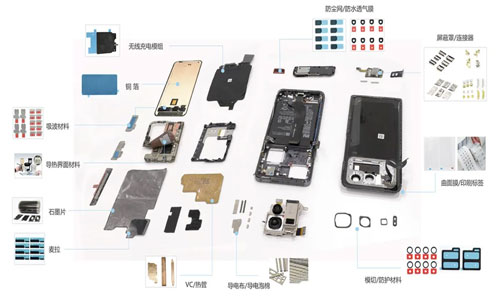Electronic devices and components emit a large amount of electromagnetic waves of different frequencies and wavelengths during operation, which can interfere with nearby circuits and devices, affecting the normal operation of precision electronic instruments and posing risks to information security. With the advancement of technology, the number of electronic devices and products is continuously increasing, and the electronic components included are becoming diverse, compact, precise, and high-density. As a result, the harm caused by electromagnetic interference is growing. Electromagnetic interference has become a problem that the electronics industry must solve.
Electromagnetic shielding materials refer to materials that have electromagnetic shielding functions. They attenuate electromagnetic waves by reflecting or absorbing the energy of electromagnetic waves, blocking the propagation path of electromagnetic waves, and achieving electromagnetic compatibility for electronic devices and components. Currently, they are widely used as an ideal solution to mitigate electromagnetic interference. The principle of electromagnetic shielding materials is as follows: when incident electromagnetic waves propagate to the surface of the shielding material, due to the impedance mismatch between air and the shielding material interface, a portion of the incident wave will be reflected back, and the remaining electromagnetic waves that enter the shielding material will be absorbed and attenuated during propagation within the material. When the partially attenuated electromagnetic waves reach another interface between the shielding material and the air, they are reflected back into the shield again due to the impedance mismatch at the interface, and they are absorbed and further attenuated.
Common electromagnetic shielding materials include conductive cloth, conductive adhesive tape, conductive foam, conductive sponge, conductive rubber, conductive coatings, absorbing materials, and so on. Their applications are widespread and are found in various industries such as communication equipment, computers, consumer electronics, automotive electronics, and defense industry.

Electromagnetic shielding materials belong to the field of application for new materials. In the industrial chain, upstream suppliers provide basic raw materials, midstream manufacturers produce electromagnetic shielding materials and devices, and downstream applications are widely used in fields such as communication equipment, computers, mobile terminals, automotive electronics, household appliances, and defense industry.
In terms of demand, with the advancement of mobile communication technology and the continuous promotion of informatization construction, the electronic industry has achieved high growth. Electronic devices have increasingly higher hardware configurations, processors are moving towards high-performance multi-core directions, large screen sizes with high resolutions are becoming more prominent, and internal component structures are gradually becoming more precise and integrated. Along with the continuous upgrading of electronic devices, higher frequencies and higher power consumption will bring higher requirements for EMI shielding protection performance, driving the continuous enrichment of electromagnetic shielding material product types, as well as further improvement in material performance and processing technology.
In terms of supply, China's electromagnetic shielding material industry started relatively late, and high-end technologies have been monopolized by manufacturers from developed countries. Therefore, at present, domestic electromagnetic shielding material manufacturers mainly focus on the low-end market. There are many participants in the low-end market, with strong homogeneity, resulting in a situation of oversupply. In the high-end market, China mainly relies on imports, but a small number of domestic manufacturers have broken through technical barriers and have the strength to research and produce high-end electromagnetic shielding products. Looking at the overall market, the production and sales volume of electromagnetic shielding materials in China is in a tight balance with supply slightly exceeding demand. From 2017 to 2021, the production and sales rate of electromagnetic shielding materials in China fluctuated between 94% and 102%.
The market size of China's electromagnetic shielding material industry experienced rapid expansion around 2018 and has now entered a period of stable growth, with no strong downstream consumer demand yet. In terms of the global market, according to BCC Research, the global electromagnetic shielding material market has gradually expanded in recent years, growing from $5.2 billion in 2013 to $7 billion in 2018, an increase of $1.8 billion in 5 years. BCC Research predicts that the global electromagnetic shielding material market will reach $9.25 billion in 2023, an increase of $2.25 billion compared to 2018, with a compound annual growth rate of 5.7%. Since 2019, the growth rate of the market has been relatively stable, and the industry has entered a relatively mature stage, with an overall situation similar to the Chinese market.
Contact: Pamela
Phone: +86 189 6365 3253
E-mail: info@industryprocess.com
Whatsapp:+86 189 6365 3253
Add: Yajing Industrial Park, No. 59 Shuangjing Street, Weiting Town, Suzhou Industrial Park
We chat
